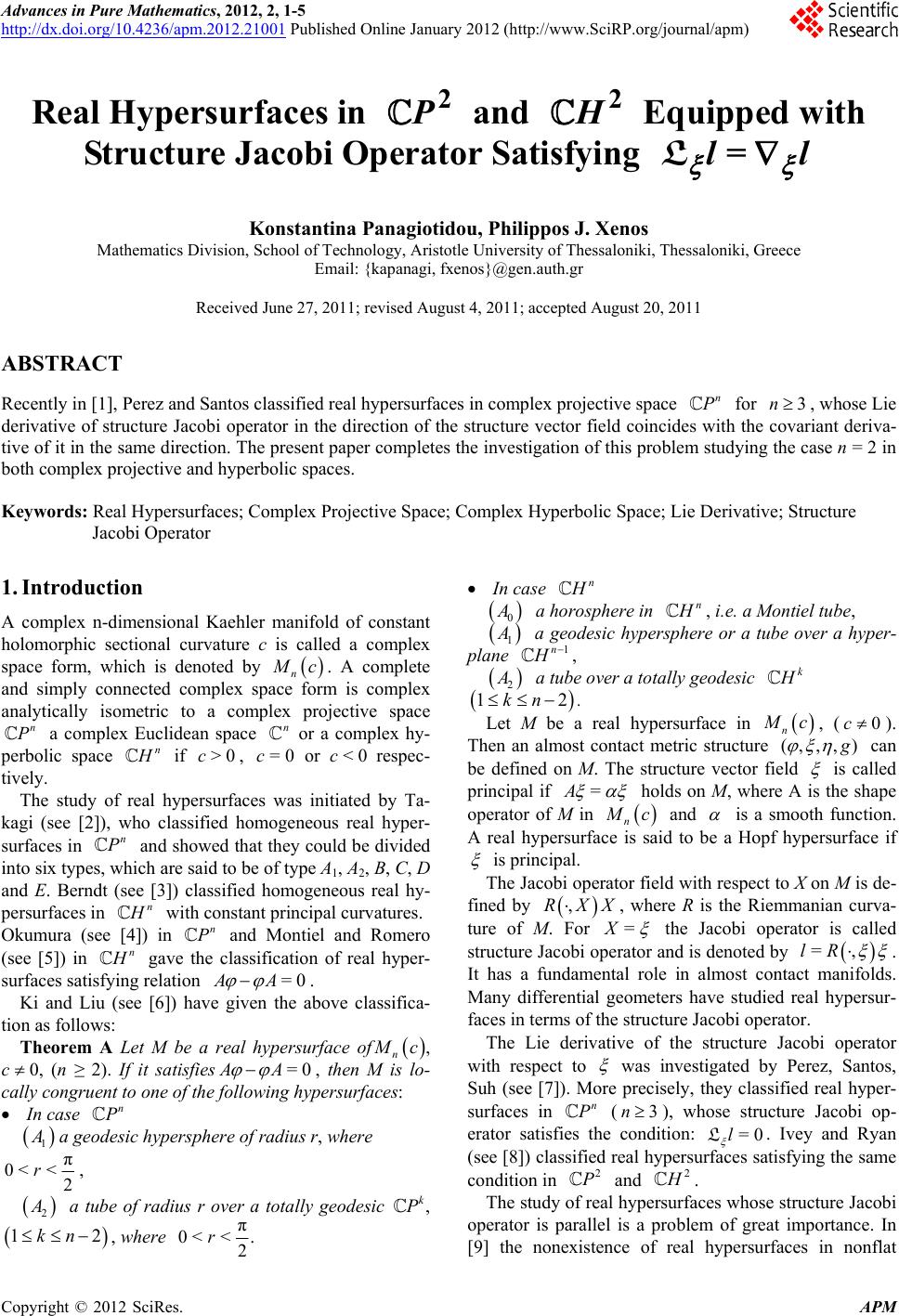 Advances in Pure Mathematics, 2012, 2, 1-5 http://dx.doi.org/10.4236/apm.2012.21001 Published Online January 2012 (http://www.SciRP.org/journal/apm) Real Hypersurfaces in 2 and 2 Equipped with Structure Jacobi Operator Satisfying =llL n Konstantina Panagiotidou, Philippos J. Xenos Mathematics Division, School of Technology, Aristotle University of Thessaloniki, Thessaloniki, Greece Email: {kapanagi, fxenos}@gen.auth.gr Received June 27, 2011; revised August 4, 2011; accepted August 20, 2011 ABSTRACT Recently in [1], Perez and Santos classified real hypersurfaces in complex projective space 3n for , whose Lie derivative of structure Jacobi operator in the direction of the structure vector field coincides with the covariant deriva- tive of it in the same direction. The present paper completes the investigation of this problem studying the case n = 2 in both complex projective and hyperbolic spaces. Keywords: Real Hypersurfaces; Complex Projective Space; Complex Hyperbolic Space; Lie Derivative; Structure Jacobi Operator 1. Introduction A complex n-dimensional Kaehler manifold of constant holomorphic sectional curvature c is called a complex space form, which is denoted by n c n . A complete and simply connected complex space form is complex analytically isometric to a complex projective space a complex Euclidean space n or a complex hy- perbolic space P n if , or c respec- tively. >0c=0 <0 n c The study of real hypersurfaces was initiated by Ta- kagi (see [2]), who classified homogeneous real hyper- surfaces in n and showed that they could be divided into six types, which are said to be of type A1, A2, B, C, D and E. Berndt (see [3]) classified homogeneous real hy- persurfaces in n P n with constant principal curvatures. Okumura (see [4]) in and Montiel and Romero (see [5]) in gave the classification of real hyper- surfaces satisfying relation =0AA . Ki and Liu (see [6]) have given the above classifica- tion as follows: Theorem A Let M be a real hypersurface of n c 0cA , , (n ≥ 2). If it satisfies=0A n , then M is lo- cally congruent to one of the following hypersurfaces: In case 1 a geodesic hypersphere of radius r, where π 0<< 2 r , 2 a tube of radius r over a totally geodesic k , 2kn1 , where π 0< <. 2 r n In case n 0 a horosphere in , i.e. a Montiel tube, 1 a geodesic hypersphere or a tube over a hyper- plane 1n , k 2 a tube over a totally geodesic 12kn n . c0c , (Let M be a real hypersurface in ). Then an almost contact metric structure (,,, ) can be defined on M. The structure vector field is called principal if =A holds on M, where A is the shape operator of M in n c and is a smooth function. A real hypersurface is said to be a Hopf hypersurface if is principal. The Jacobi operator field with respect to X on M is de- fined by ,RXX =X , where R is the Riemmanian curva- ture of M. For the Jacobi operator is called structure Jacobi operator and is denoted by =,lR . It has a fundamental role in almost contact manifolds. Many differential geometers have studied real hypersur- faces in terms of the structure Jacobi operator. The Lie derivative of the structure Jacobi operator with respect to was investigated by Perez, Santos, Suh (see [7]). More precisely, they classified real hyper- surfaces in n 3 =0l 2 (n), whose structure Jacobi op- erator satisfies the condition: L. Ivey and Ryan (see [8]) classified real hypersurfaces satisfying the same condition in 2 and . The study of real hypersurfaces whose structure Jacobi operator is parallel is a problem of great importance. In [9] the nonexistence of real hypersurfaces in nonflat C opyright © 2012 SciRes. APM 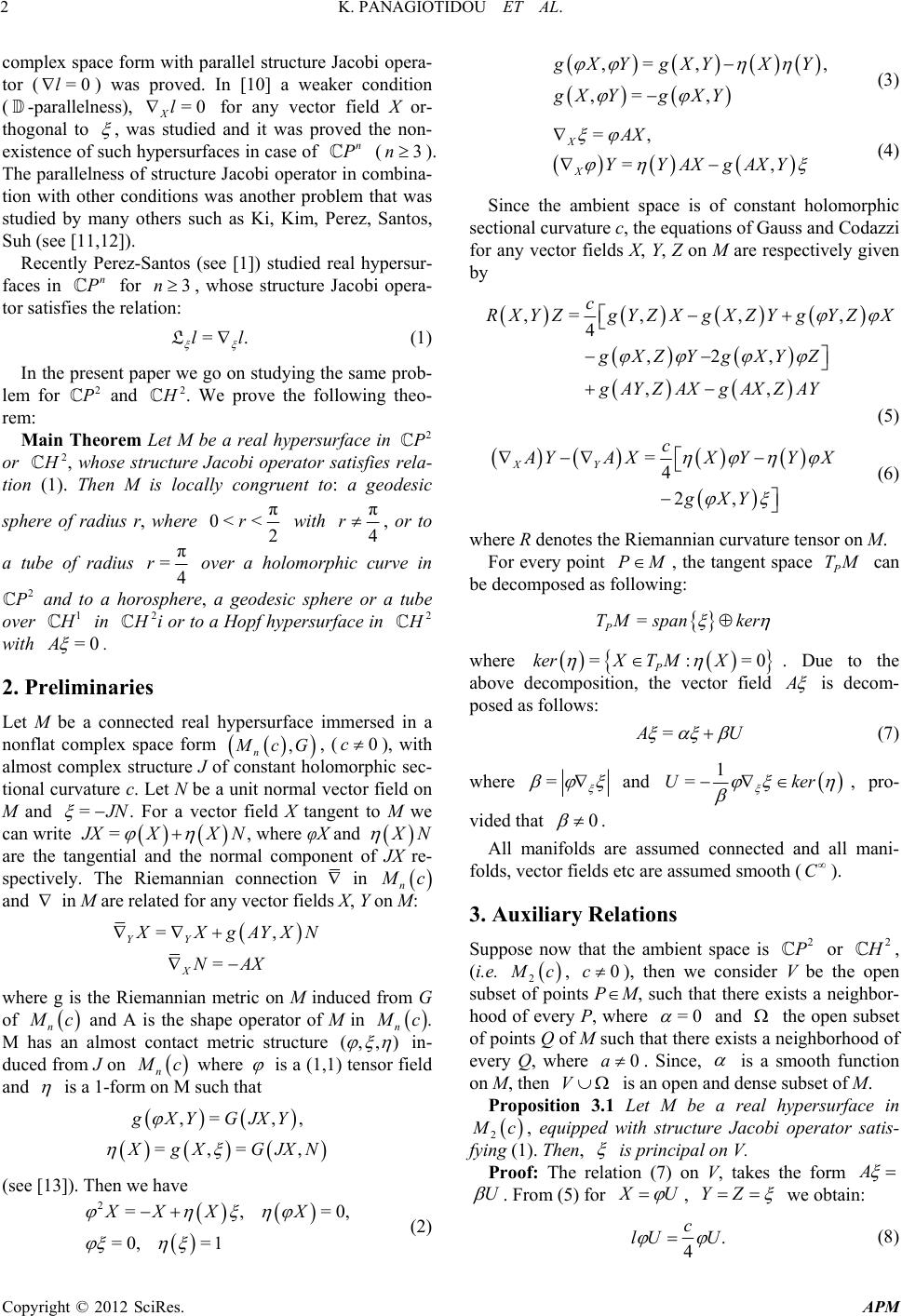 K. PANAGIOTIDOU ET AL. 2 ,= ,, ,= , complex space form with parallel structure Jacobi opera- tor () was proved. In [10] a weaker condition (-parallelness), X for any vector field X or- thogonal to XY gXYXY gX YgXY =, =, X X AX YYAXgAXY =0l =0l , was studied and it was proved the non- existence of such hypersurfaces in case of n 3 n (n). The parallelness of structure Jacobi operator in combina- tion with other conditions was another problem that was studied by many others such as Ki, Kim, Perez, Santos, Suh (see [11,12]). Recently Perez-Santos (see [1]) studied real hypersur- faces in for , whose structure Jacobi opera- tor satisfies the relation: 3n =.ll L P H P H (1) In the present paper we go on studying the same prob- lem for 2 and 2. We prove the following theo- rem: Main Theorem Let M be a real hypersurface in 2 or 2, whose structure Jacobi operator satisfies rela- tion (1). Then M is locally congruent to: a geodesic sphere of radius r, where π <2 r0< with π 4 r, or to a tube of radius π =4 r over a holomorphic curve in 2 and to a horosphere, a geodesic sphere or a tube over P 1 A in 2i or to a Hopf hypersurface in 2 with HH =0 . 2. Preliminaries Let M be a connected real hypersurface immersed in a nonflat complex space form , n cG 0c = , (), with almost complex structure J of constant holomorphic sec- tional curvature c. Let N be a unit normal vector field on M and N . For a vector field X tangent to M we can write = XX XN , where φX and N are the tangential and the normal component of JX re- spectively. The Riemannian connection in n c and in M are related for any vector fields X, Y on M: =, YY XgAYXN = XNAX where g is the Riemannian metric on M induced from G of n c and A is the shape operator of M in n c (,,) . M has an almost contact metric structure in- duced from J on n c where is a (1,1) tensor field and is a 1-form on M such that ,= ,, XY G JXY = , =, gX GJXN =0,X (see [13]). Then we have 2=, =0, =1 XX X (2) (3) (4) Since the ambient space is of constant holomorphic sectional curvature c, the equations of Gauss and Codazzi for any vector fields X, Y, Z on M are respectively given by ,= ,,, 4 ,2, ,, c RXYZgYZXgXZY gYZX gXZYgXYZ gAYZAXgAXZAY (5) =4 2, XY c YAX XYYX gXY PM (6) where R denotes the Riemannian curvature tensor on M. For every point , the tangent space can be decomposed as following: P TM = P T Mspanker where =:=0kerXTMX P. Due to the above decomposition, the vector field is decom- posed as follows: U= (7) where = and 1 =U ker 0 , pro- vided that . All manifolds are assumed connected and all mani- folds, vector fields etc are assumed smooth (C ). 3. Auxiliary Relations 2 2 or Suppose now that the ambient space is , (i.e. 2c0c, ), then we consider V be the open subset of points P M, such that there exists a neighbor- hood of every P, where =0 and the open subset of points Q of M such that there exists a neighborhood of every Q, where 0a . Since, is a smooth function on M, then is an open and dense subset of M. V Proposition 3.1 Let M be a real hypersurface in 2 c, equipped with structure Jacobi operator satis- fying (1). Then, is principal on V. A Proof: The relation (7) on V, takes the form U UYZ . From (5) for , we obtain: . 4 c lU U (8) Copyright © 2012 SciRes. APM 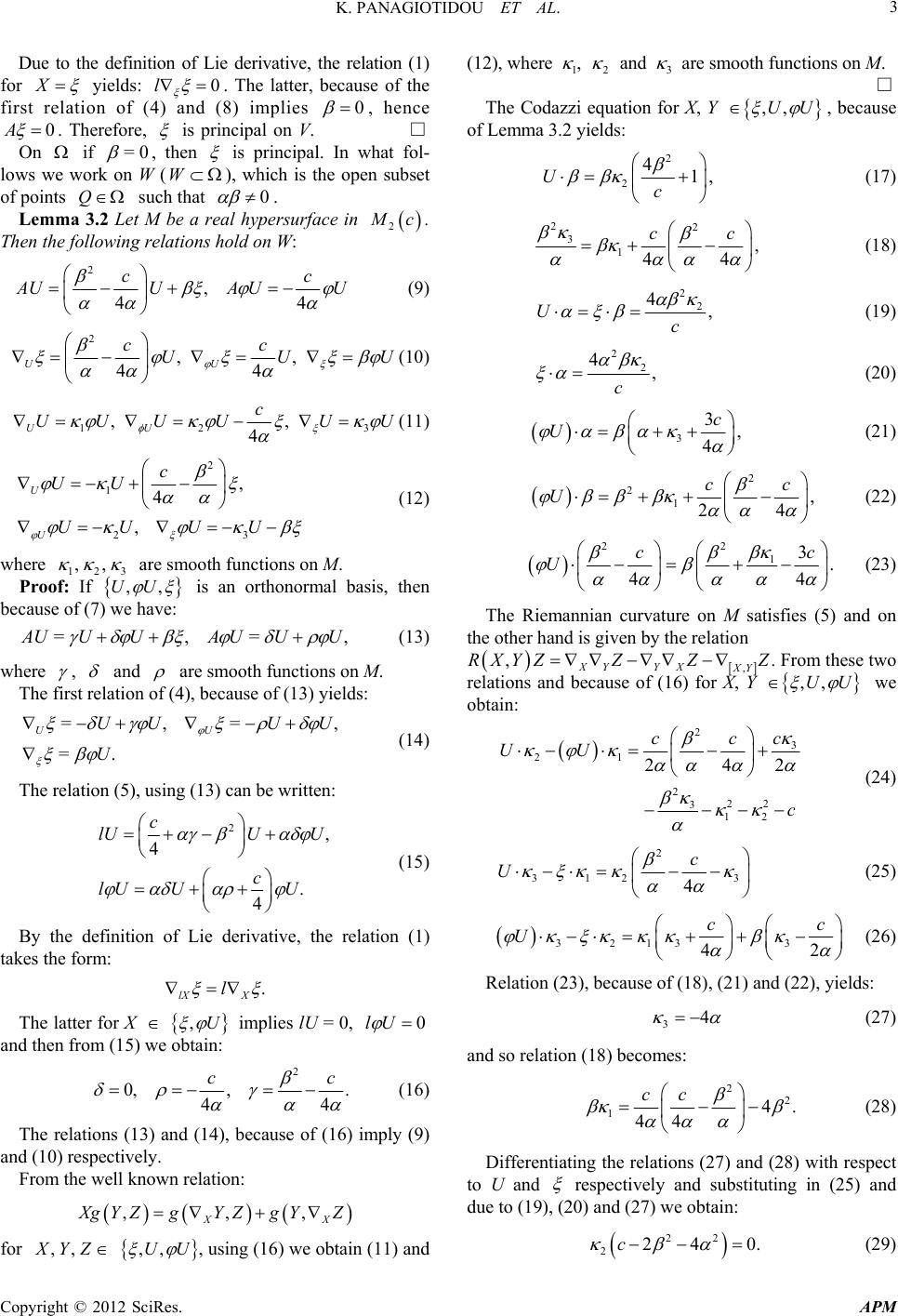 K. PANAGIOTIDOU ET AL. 3 Due to the definition of Lie derivative, the relation (1) for X yields: l 0 0 . The latter, because of the first relation of (4) and (8) implies A , hence 0 . Therefore, is principal on V. □ On if =0 , then is principal. In what fol- lows we work on W (W), which is the open subset of points such that 0 Q . Lemma 3.2 Let M be a real hypersurface in 2 c. Then the following relations hold on W: 2 , 44 cc UU AUU (9) 2 , 44 UU cc UU , U (10) 12 ,, 4 UU c UUU U 3 UU (11) 2 23 , UU 14 , U U c UU UU 3 ,, ,,UU (12) where are smooth functions on M. 12 Proof: If =,=, is an orthonormal basis, then because of (7) we have: UU UAUUU (13) where , and are smooth functions on M. The first relation of (4), because of (13) yields: =, =. U U = , U UU UU (14) The relation (5), using (13) can be written: 2 4 c lU lU U , . 4 U U cU . lX X l (15) By the definition of Lie derivative, the relation (1) takes the form: The latter for X ,U 0lU implies lU = 0, and then from (15) we obtain: 2 44 cc 0, ,. , XX (16) The relations (13) and (14), because of (16) imply (9) and (10) respectively. From the well known relation: ,, gYZgYZ ,, gY Z for YZ ,,UU , using (16) we obtain (11) and (12), where 1 , 2 and 3 are smooth functions on M. □ ,,UU The Codazzi equation for X, Y , because of Lemma 3.2 yields: 2 2 41,Uc (17) 22 3 1, 44 cc (18) 2 2 4,Uc (19) 2 2 4, c (20) 3 3, 4 c U (21) 2 2 1, 24 cc U (22) 22 13. 44 cc U (23) The Riemannian curvature on M satisfies (5) and on the other hand is given by the relation ,RXYZZZ Z ,,UU , XY YXXY . From these two relations and because of (16) for X, Y we obtain: 2 3 21 2 22 3 12 242 c cc UU c (24) 2 312 3 4 c U (25) 3213 3 42 cc U 34 (26) Relation (23), because of (18), (21) and (22), yields: (27) and so relation (18) becomes: 2 2 14. 44 cc (28) Differentiating the relations (27) and (28) with respect to U and respectively and substituting in (25) and due to (19), (20) and (27) we obtain: 22 224 0c . (29) Copyright © 2012 SciRes. APM 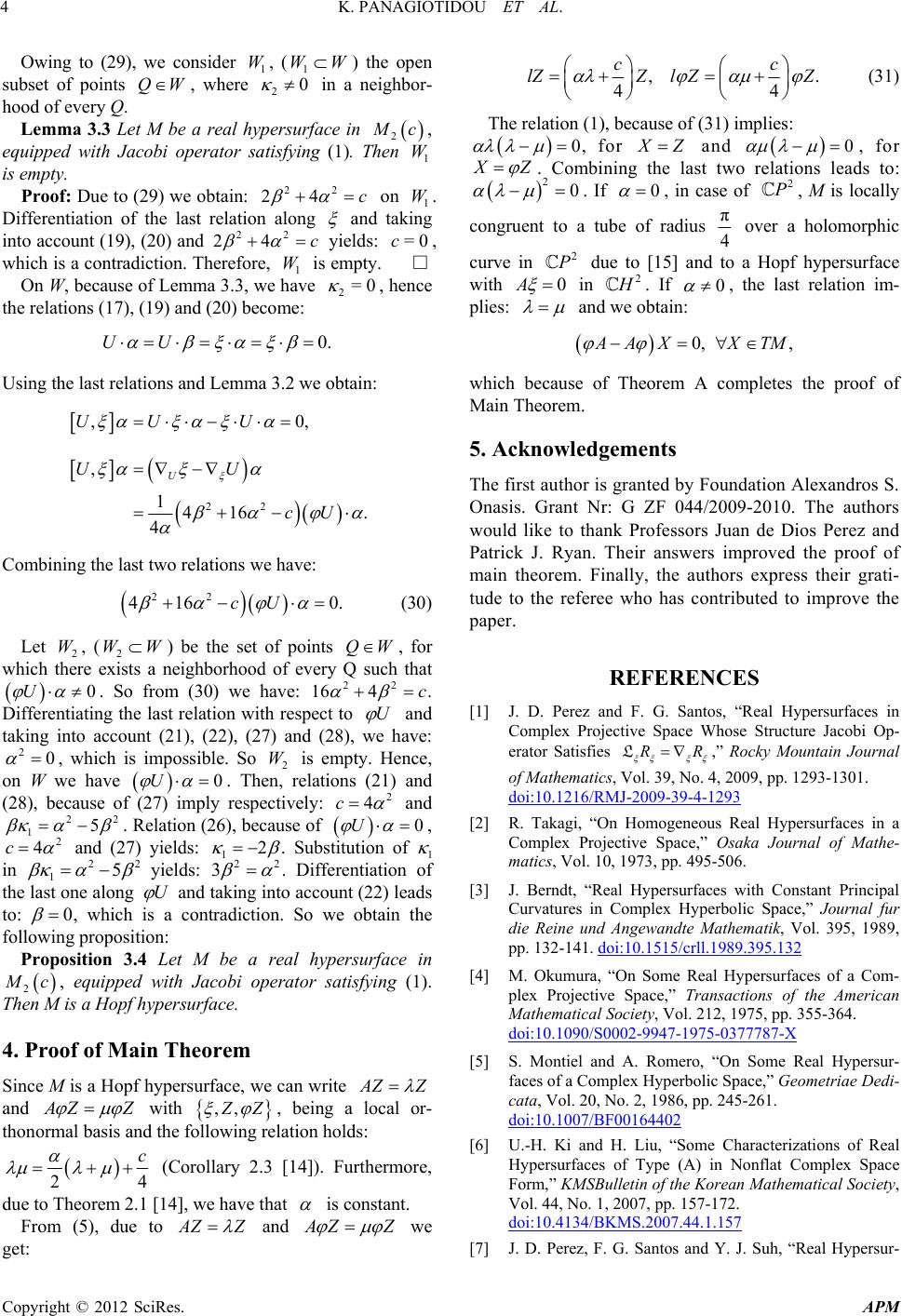 K. PANAGIOTIDOU ET AL. 4 Owing to (29), we consider , (W) the open subset of points , where in a neighbor- hood of every Q. 1 W1W 20 QW Lemma 3.3 Let M be a real hypersurface in 2 c 1 W 2 c , equipped with Jacobi operator satisfying (1). Then is empty. Proof: Due to (29) we obtain: on 1 W. Differentiation of the last relation along 2 24 and taking into account (19), (20) and yields: , which is a contradiction. Therefore, is empty. □ 2 24 2 c =0c 2=0 0. 1 On W, because of Lemma 3.3, we have , hence the relations (17), (19) and (20) become: W UU Using the last relations and Lemma 3.2 we obtain: ,0,U UU .cU 22 , 1416 4 U UU 0cU WWQW Combining the last two relations we have: 22 416 . (30) Let 2, (2) be the set of points W , for which there exists a neighborhood of every Q such that . So from (30) we have: 16 . Differentiating the last relation with respect to U 0 22 4c U and taking into account (21), (22), (27) and (28), we have: , which is impossible. So 2 is empty. Hence, on W we have . Then, relations (21) and (28), because of (27) imply respectively: 20 W U 0 2 4c 2 and 2 5 1 . Relation (26), because of 0U , 2 4c and (27) yields: 1 2 . Substitution of 1 in 1 2 52 yields: 322 . Differentiation of the last one along U and taking into account (22) leads to: 0 , which is a contradiction. So we obtain the following proposition: Proposition 3.4 Let M be a real hypersurface in 2 c, equipped with Jacobi operator satisfying (1). Then M is a Hopf hypersurface. 4. Proof of Main Theorem Since M is a Hopf hypersurface, we can write ZZ and ZZ with ,, Z , being a local or- thonormal basis and the following relation holds: 24 c (Corollary 2.3 [14]). Furthermore, due to Theorem 2.1 [14], we have that is constant. From (5), due to ZZ and ZZ we get: ,. 44 cc lZZl ZZ (31) The relation (1), because of (31) implies: 0 , for Z and , for 0 Z . Combining the last two relations leads to: 20 2 , M is locally 0 . If , in case of congruent to a tube of radius π 4 2 over a holomorphic curve in 0A due to [15] and to a Hopf hypersurface with 2 . If in 0 , the last relation im- plies: and we obtain: 0, , AX XTM which because of Theorem A completes the proof of Main Theorem. 5. Acknowledgements The first author is granted by Foundation Alexandros S. Onasis. Grant Nr: G ZF 044/2009-2010. The authors would like to thank Professors Juan de Dios Perez and Patrick J. Ryan. Their answers improved the proof of main theorem. Finally, the authors express their grati- tude to the referee who has contributed to improve the paper. REFERENCES [1] J. D. Perez and F. G. Santos, “Real Hypersurfaces in Complex Projective Space Whose Structure Jacobi Op- erator Satisfies R ,” Rocky Mountain Journal of Mathematics, Vol. 39, No. 4, 2009, pp. 1293-1301. L doi:10.1216/RMJ-2009-39-4-1293 [2] R. Takagi, “On Homogeneous Real Hypersurfaces in a Complex Projective Space,” Osaka Journal of Mathe- matics, Vol. 10, 1973, pp. 495-506. [3] J. Berndt, “Real Hypersurfaces with Constant Principal Curvatures in Complex Hyperbolic Space,” Journal fur die Reine und Angewandte Mathematik, Vol. 395, 1989, pp. 132-141. doi:10.1515/crll.1989.395.132 [4] M. Okumura, “On Some Real Hypersurfaces of a Com- plex Projective Space,” Transactions of the American Mathematical Society, Vol. 212, 1975, pp. 355-364. doi:10.1090/S0002-9947-1975-0377787-X [5] S. Montiel and A. Romero, “On Some Real Hypersur- faces of a Complex Hyperbolic Space,” Geometriae Dedi- cata, Vol. 20, No. 2, 1986, pp. 245-261. doi:10.1007/BF00164402 [6] U.-H. Ki and H. Liu, “Some Characterizations of Real Hypersurfaces of Type (A) in Nonflat Complex Space Form,” KMSBulletin of the Korean Mathematical Society, Vol. 44, No. 1, 2007, pp. 157-172. doi:10.4134/BKMS.2007.44.1.157 [7] J. D. Perez, F. G. Santos and Y. J. Suh, “Real Hypersur- Copyright © 2012 SciRes. APM 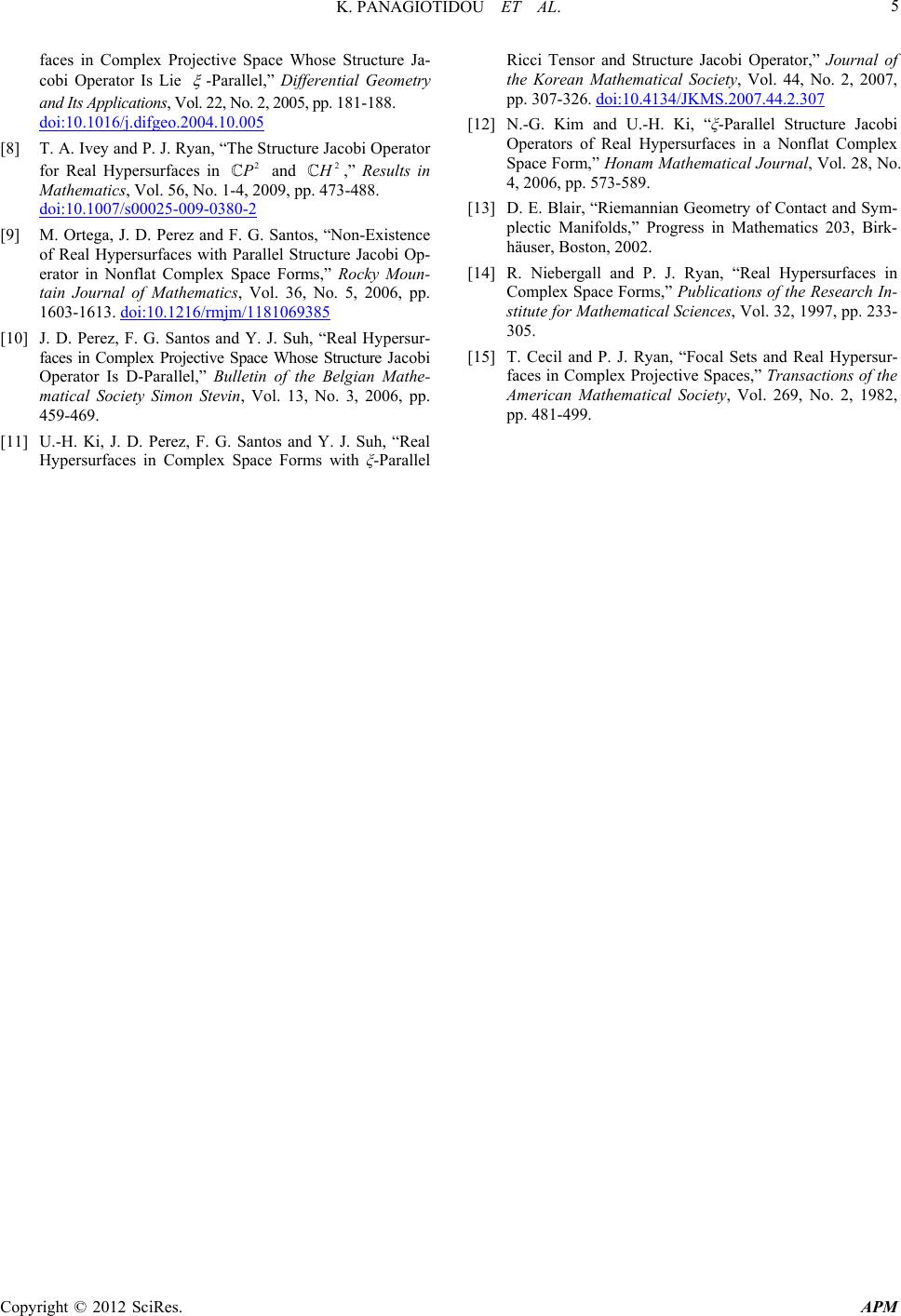 K. PANAGIOTIDOU ET AL. Copyright © 2012 SciRes. APM 5 faces in Complex Projective Space Whose Structure Ja- cobi Operator Is Lie -Parallel,” Differential Geometry and Its Applications, Vol. 22, No. 2, 2005, pp. 181-188. doi:10.1016/j.difgeo.2004.10.005 [8] T. A. Ivey and P. J. Ryan, “The Structure Jacobi Operator for Real Hypersurfaces in 2 P and 2 H,” Results in Mathematics, Vol. 56, No. 1-4, 2009, pp. 473-488. doi:10.1007/s00025-009-0380-2 [9] M. Ortega, J. D. Perez and F. G. Santos, “Non-Existence of Real Hypersurfaces with Parallel Structure Jacobi Op- erator in Nonflat Complex Space Forms,” Rocky Moun- tain Journal of Mathematics, Vol. 36, No. 5, 2006, pp. 1603-1613. doi:10.1216/rmjm/1181069385 [10] J. D. Perez, F. G. Santos and Y. J. Suh, “Real Hypersur- faces in Complex Projective Space Whose Structure Jacobi Operator Is D-Parallel,” Bulletin of the Belgian Mathe- matical Society Simon Stevin, Vol. 13, No. 3, 2006, pp. 459-469. [11] U.-H. Ki, J. D. Perez, F. G. Santos and Y. J. Suh, “Real Hypersurfaces in Complex Space Forms with ξ-Parallel Ricci Tensor and Structure Jacobi Operator,” Journal of the Korean Mathematical Society, Vol. 44, No. 2, 2007, pp. 307-326. doi:10.4134/JKMS.2007.44.2.307 [12] N.-G. Kim and U.-H. Ki, “ξ-Parallel Structure Jacobi Operators of Real Hypersurfaces in a Nonflat Complex Space Form,” Honam Mathematical Journal, Vol. 28, No. 4, 2006, pp. 573-589. [13] D. E. Blair, “Riemannian Geometry of Contact and Sym- plectic Manifolds,” Progress in Mathematics 203, Birk- häuser, Boston, 2002. [14] R. Niebergall and P. J. Ryan, “Real Hypersurfaces in Complex Space Forms,” Publications of the Research In- stitute for Mathematical Sciences, Vol. 32, 1997, pp. 233- 305. [15] T. Cecil and P. J. Ryan, “Focal Sets and Real Hypersur- faces in Complex Projective Spaces,” Transactions of the American Mathematical Society, Vol. 269, No. 2, 1982, pp. 481-499.
|